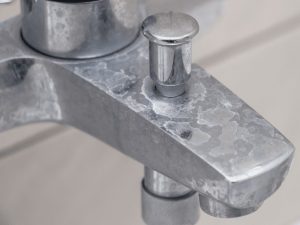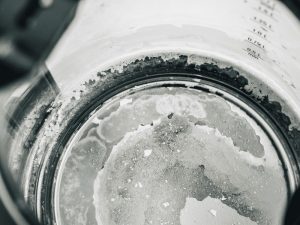Hard Water in the Home: The Impact of Limescale
- Home
- >
- Help & Advice Centre
- >
- Hard Water in the Home: The Impact of Limescale
Hard water is a widespread issue in the UK, affecting over 60% of households. Though many people grow accustomed to it, hard water causes more than just mild inconvenience. From appliance damage to stubborn residue, it creates ongoing problems in the home – primarily through the formation of limescale.

Hard water contains elevated levels of dissolved minerals, primarily calcium and magnesium. Water hardness is typically measured in parts per million (ppm). Anything below 100ppm is considered soft to moderately soft, 100–200ppm is moderately hard, and above 200ppm is classed as hard to very hard.
Hardness occurs naturally as water passes through mineral-rich areas like chalk or limestone. The UK’s water supply, mostly drawn from rivers, reservoirs, and underground sources such as aquifers, is often exposed to these minerals.
There are two types of hard water: temporary and permanent. Temporary hardness, the most common type, leads to limescale formation as the minerals precipitate out when water evaporates or is heated.
Limescale is the chalky residue left behind when hard water evaporates or is heated. It often appears as a white or yellowish deposit, although it may take on a reddish tint if iron is present.
Over time, limescale hardens into thick layers that cling to surfaces and internal parts of appliances. The harder the water, the more rapidly and extensively this build-up occurs.
Limescale causes damage to many household appliances, especially those that use hot water. The heating elements in washing machines, dishwashers, and boilers are particularly vulnerable. As scale builds up on these components, they lose efficiency and eventually fail.
These appliances rely on heating elements to operate efficiently. Limescale accumulation on these elements creates hotspots, leading to increased energy use and eventual breakdown. In washing machines, scale can also damage hoses, drums, and pipes. Clothes washed in hard water may feel rough and irritate sensitive skin. Dishwashers are also affected, with scale coating the interior and leaving marks on dishes and cutlery.
These small appliances also suffer from limescale due to frequent water heating. In steam ovens and coffee machines, scale can block internal pipes and nozzles, disrupting performance or halting operation altogether. In coffee machines, it may even affect the taste and temperature of the drink. Irons can become clogged with scale, preventing steam release.
Boiling water taps face the same risks, though many come with optional filters to prevent scale build-up. If filters are ignored or not replaced, the hot water tank can eventually scale over and stop working.
 Kettles
KettlesPerhaps the most familiar example, kettles often show signs of limescale on the heating plate and interior surfaces. The buildup slows boiling time, reduces energy efficiency, and may even result in flakes of scale ending up in your drink.
Over time, the kettle’s heating element will fail completely.
Electric showers are highly vulnerable, as their internal heaters are prone to the same scale problems as other appliances. Even standard showerheads can become blocked, both inside and at the nozzle level, affecting water flow. Visually, limescale also leaves noticeable marks on shower fittings.
Although toilets aren’t as heavily affected, scale can still cause long-term issues. Visible stains may form in the bowl, particularly when iron is present. The more serious concern lies in the cistern, where scale may impair the flush mechanism over time.
Limescale doesn’t just damage appliances; it also affects surfaces throughout the home. If not regularly cleaned, it can lead to staining, scratching, and even permanent damage.
Glass surfaces, especially shower screens and glass kettles, often become cloudy due to limescale deposits. If left uncleaned, these marks can etch into the glass, leaving permanent blemishes.
Granite is commonly found in kitchens, particularly around sinks where limescale tends to form. While durable, granite is sensitive to certain cleaning agents. Many chemical descalers can damage the surface finish, making removal of build-up more challenging.
Frequently used in both kitchens and bathrooms, stainless steel is tough but not immune to limescale. Deposits can scratch the surface if removed aggressively, and prolonged contact may lead to pitting. This damage is often linked to bacteria that colonize limescale, rather than the deposits themselves.
Limescale affects tile types differently. Glossy tiles are easier to clean, as scale adheres less strongly. Natural stone tiles, on the other hand, are porous and allow water, and subsequently limescale, to penetrate, leading to stains and difficult-to-remove deposits.
Hard water and limescale pose more than just cosmetic issues, they affect appliance performance, raise energy bills, and shorten the lifespan of valuable home systems. Fortunately, these problems can be managed.
The most effective strategy is prevention, usually achieved through water treatment. Options include water softeners and water conditioners. Both help limit scale formation, though they operate differently. Water softeners remove the minerals entirely, while conditioners alter the way minerals behave, reducing their ability to bond.
If you’re seeking a low-maintenance, chemical-free option, a passive water conditioner such as Halcyan could be an ideal fit. Before choosing a solution, it’s worth researching which system matches your household needs best.
If you would like to find out more about the best hard water solution for you, our expert plumbers are on hand to help. Just get in touch!